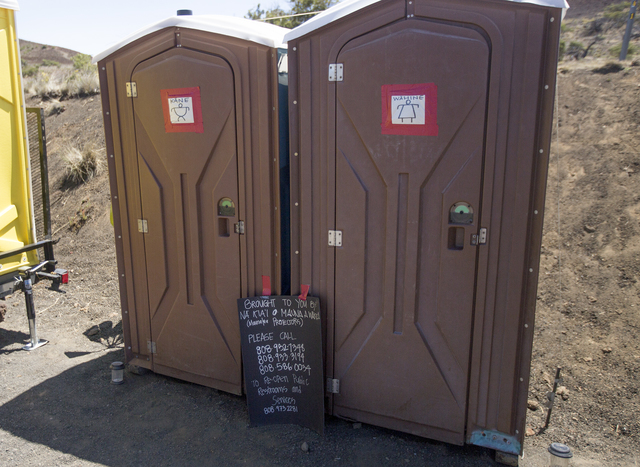Protesters of the Thirty Meter Telescope say they are being unfairly targeted by the state’s proposed “emergency” rules restricting access to Mauna Kea’s summit.
“They’re fishing for something to do, some way to get us off (the mountain) and allow TMT up,” said Lanakila Mangauil, one of the organizers of the protests. “It’s so obvious that the state is catering to a private project.”
“It surely seems like something that is a direct response to what we . . . have been doing on the mountain for the past 104 days,” Kahookahi Kanuha, another protest leader, wrote in a message Tuesday. “They are trying to make the protection efforts . . . more difficult.”
The proposed new rules would prohibit backpacks, blankets and other “obvious camping paraphernalia” and limit the hours during which individuals could remain in a designated restricted area within 1 mile of the Mauna Kea Access Road.
In a joint statement Tuesday, the state Attorney General’s office and Department of Land and Natural Resources said the changes are needed to ensure safe access to the summit.
“In recent weeks, dozens of people have camped on the grounds or remained parked in cars for prolonged periods, either on or near the access road to Mauna Kea,” Attorney General Doug Chin said in a statement. “Boulders and rock walls have been placed on the road. Invasive species have been introduced. Unauthorized toilets have been placed on the grounds. Individuals remaining in the area have reportedly caused visitors and workers to feel harassed. Consumption of water, which must be trucked up the mountain, is at record high usage. All of this has occurred in a partially graveled, steeply graded area without markings or guardrails.”
How exactly the new rules would be enforced, and how they would impact tour companies and other visitors, remains to be seen. One thing that is clear, however, is that existing rules already prohibit camping on the mountain.
Asked why the state didn’t opt simply to enforce current camping restrictions, Joshua Wisch, a spokesman for Chin, wrote, “Enforcement against individuals who violate current camping prohibitions is an option, but the proposed rule clarifies that camping-related equipment is prohibited in a designated area and schedules nighttime hours during which individuals may not remain within that area.”
In response to hypothetical situations raised by the Tribune-Herald — for example, what happens to a tourist who spends an hour or more stargazing at the summit and uses a blanket to keep warm? — Wisch noted the rule is a proposal that can be adopted, rejected or amended by the state Land Board.
The board is scheduled to discuss the proposed rules during its meeting Friday in Honolulu.
The rules, as the Tribune-Herald first reported Tuesday, would prohibit camping-related equipment and prevent people from entering or remaining in the area between 8 p.m. and 5 a.m., “except to the extent the person is transiting through the restricted area in a motor vehicle on the Mauna Kea Observatory Access Road.”
Protesters, who call themselves protectors of the mountain, argue that what they are doing outside the Mauna Kea Visitors Information Station is not camping.
“Camping is a recreational thing. We are not there recreationally,” Mangauil said. “We are occupying the space. We are protecting this space.”
In his submittal to the Land Board, Scott Fretz, acting administrator of DLNR’s Division of Forestry and Wildlife, asked the board to find there is an “imminent peril to public safety and the state’s natural resources” related to the encampment and approve the new rules.
In addition to numerous law enforcement actions that have placed staff, officers and the public at risk, Fretz wrote the presence of protesters is “resulting in impacts to the natural resources through trampling and other direct impacts, as well as by the accumulation of waste, litter and other disposables.”
Mangauil called Fretz’s statement “bogus,” “totally fictitious” and “made up.” The reality, he said, is that his small group has taken it upon themselves to keep the area cleaner than it ever has been.
“I’m going to advocate for them to show any kind of proof that we’re having a detrimental impact to the natural resources,” he said.
Mangauil added that he finds it ironic the state is focusing on the alleged impacts of a small group of protesters when TMT is planning to construct a $1.4 billion 18-story telescope on the mountain’s summit.
Meanwhile, the closure of the access road is expected to continue for the rest of the week, said Dan Meisenzahl, spokesman for University of Hawaii, which manages the road.
The Mauna Kea Observatories Support Services’ three-man road crew today will begin removing rock piles officials say still remain at locations on the side of the access road following the TMT protest June 24.
The rocks will be used for planned maintenance on one of the first switchbacks on the road above Hale Pohaku, Meisenzahl said.
Protesters cleared the rocks, which they used to block construction vehicles, from the road following the protest, but UH has maintained that some rock piles on the road’s edges still are partially in the way of road graders.
Grading will be completed after the rock piles are removed.
The lengthy road closure has frustrated Hawaiian cultural practitioners, who are limited to driving to the summit via escort once a day, and tour operators who depend on access to the top of Hawaii’s tallest peak for their business.
The proposed rules can be viewed at dlnr.hawaii.gov/dofaw/draft-rules, or in person at the DOFAW Office on Hawaii Island at 19 E. Kawili Street, Hilo, Hawaii 96720 during regularly scheduled business hours.
Reporter Tom Callis contributed to this report.
Email Chris D’Angelo at cdangelo@hawaiitribune-herald.com.






